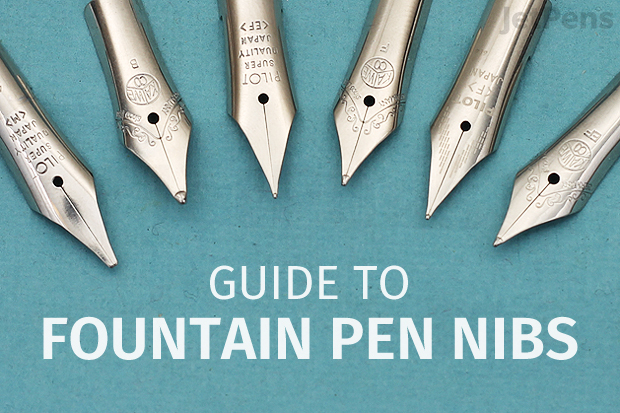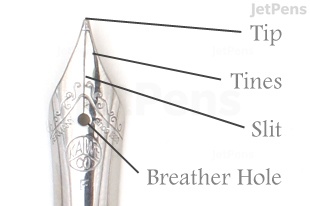Like a car and its tires, a fountain pen will only write as well as the nib it is paired with. The nib is responsible for determining how a fountain pen will write, making it the first thing that should be considered when choosing a fountain pen. Let’s take a look at how a fountain pen nib works and what things you should consider when picking one out.
What is a Nib?
NIB CHARACTERISTICS
The four most important characteristics when choosing a fountain pen nib are tip shape, tip size, flexibility, and nib material.
Tip Shape
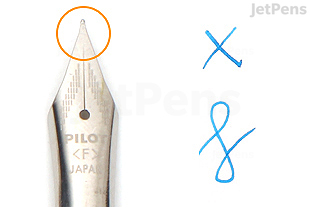
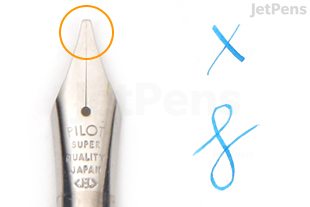
There are many other tip shapes out there as well, including left-handed, oblique, zoom, and Arabic/Hebrew, but these are mainly used for specialized purposes and are much less common than round or italic nibs.
Tip Size
After tip shape, the tip size of a nib will have the biggest impact on how a fountain pen writes. Larger tip sizes create wide lines suitable for bold writing and showcasing the ink used, but many people prefer smaller tip sizes for everyday writing because they create a line width closer to that of a typical ballpoint or gel pen.
Round nibs typically fall into one of four tip sizes: Extra Fine (EF), Fine (F), Medium (M), and Broad (B). Italic nibs can be sized using the same conventions, or in terms of the actual width of their tips. The most common italic nib sizes are medium italic and 1.1 mm italic, which are generally equivalent.
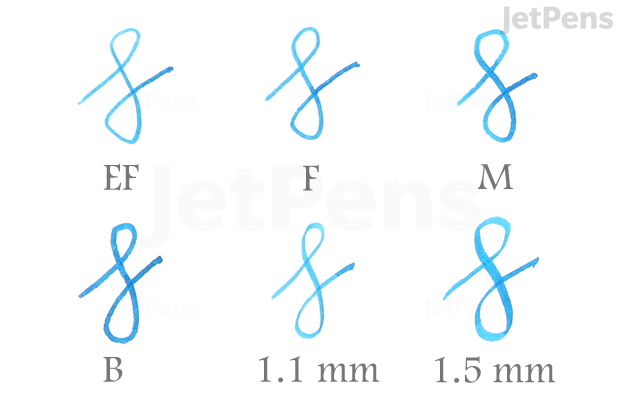
Just knowing the size of a nib is not enough, however. Japanese fountain pens typically have much smaller tips than non-Japanese or “Western” brands. This is because Japanese writing is much denser and more complex than Western writing, requiring a finer, more precise tip.
The actual line width created by a particular fountain pen can vary depending on a number of factors such as the ink and paper being used, but the following table shows typical line widths that can be expected from most Japanese and Western nibs under normal conditions.
Typical Line Widths for Western and Japanese Fountain Pens
| Extra Fine (EF) | Fine (F) | Medium (M) | Broad (B) | |
|---|---|---|---|---|
| Western | 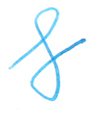 0.5 mm |
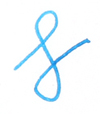 0.6 mm |
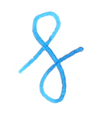 0.75 mm |
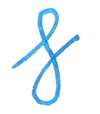 0.9 mm |
| Japanese |  0.3 mm |
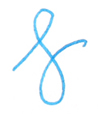 0.45 mm |
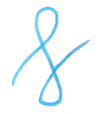 0.6 mm |
* |
Below are listed some of the major Western and Japanese fountain pen brands. Note that some brands like Ohto and TWSBI are considered Western despite being located in Asia because they source their nibs from European manufacturers that use Western sizing.
| Western Fountain Pen Brands | |
|---|---|
| Kaweco |  |
| Lamy |  |
| Monteverde |  |
| Ohto |  |
| Parker |  |
| Pelikan |  |
| Regal |  |
| Retro 51 |  |
| TWSBI |  |
| Japanese Fountain Pen Brands | |
| Pilot |  |
| Platinum* |  |
| Sailor |  |
Besides the obvious difference of line width, there are other factors to consider when choosing a tip size.
Broader nibs often have higher ink flow than finer nibs, creating both a wider and thicker line of ink. The faster ink flow lubricates the nib to create a smoother, more effortless writing experience. However, it can also make the ink more likely to feather or bleed through lower-quality papers. For more information on selecting fountain pen friendly paper, check out our article here.
Finer nibs, on the other hand, tend to have a more controlled flow, making them more tolerant of varying qualities of paper. Finer nibs are typically not quite as smooth as broader nibs, however, and very fine nibs like Japanese EFs can actually dig into the paper if too much pressure is used.
Pros and Cons of Finer and Broader Nibs
| Finer Nibs | Broader Nibs | |
|---|---|---|
| Pros |
|
|
| Cons |
|
|
Flexibility
Flexibility refers to how far a nib’s tines will spread open when pressure is put on the nib, creating variations in line width. Back in the days when formal cursive scripts like Spencerian and Copperplate were still in regular use, it was common for nibs to be made with very high flexibility. Nowadays, virtually all fountain pens use firm nibs that have little flexibility, and the few modern flexible or “soft” nibs like those of the Pilot Elabo (also known as the Pilot Falcon) would only be considered semi-flexible when compared to a vintage flexible nib.
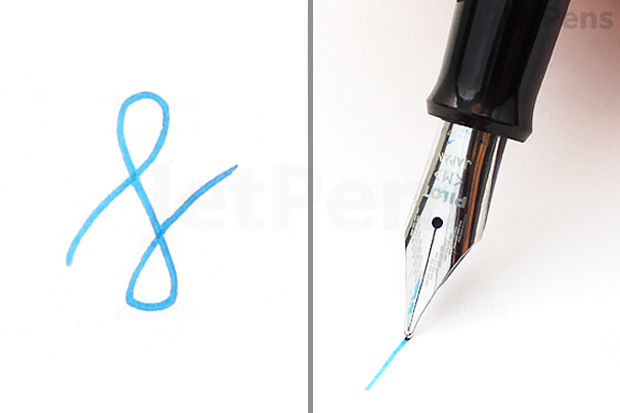
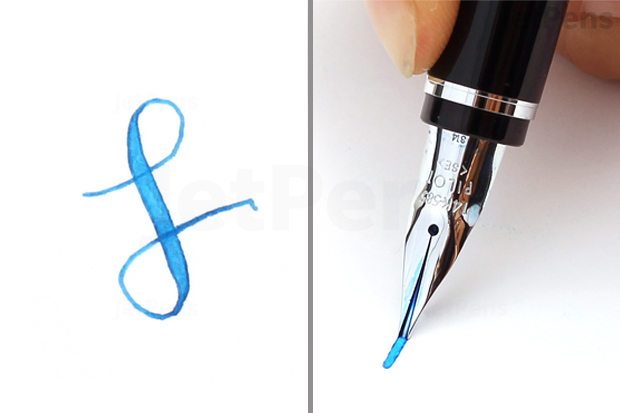
Some firm nibs, like Lamy’s steel nibs, offer almost no line variation and are sometimes referred to as “nails.” Other steel nibs and most gold nibs can provide a modest amount of line variation when pressed, but it is important to remember that they are not designed for use as flex pens. Over-flexing can cause serious and possibly irreparable damage to a nib.
Like italic nibs, semi-flex nibs can be fun to use and add character to your writing, but they also require practice and concentration to use well. For a go-to daily writer, a firm nib may be preferable.
Nib Material
Nib material is a less important factor when choosing a fountain pen, as it has a smaller impact on the way a nib writes. Nibs are made from many different materials, but most fountain pens will have either a gold or stainless steel nib.
Note that the color of a nib does not necessarily indicate whether it is made from gold or steel. Kaweco steel nibs are available in steel, gold, and black colors, and many gold nibs are plated with a silvery metal like rhodium. Real gold nibs will almost always have an imprint specifying its gold content, usually 14K or 18K.

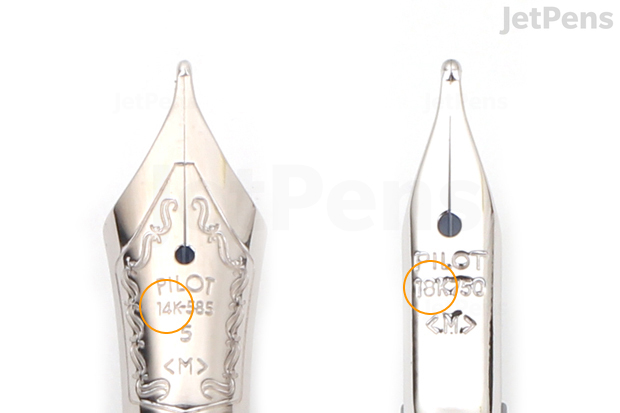
Gold nibs are not necessarily better or smoother than steel nibs. The smoothness of a nib is largely determined by its tipping, and both steel and gold nibs are almost always tipped with an alloy of other, harder metals like iridium, osmium, and tungsten, so the material of the nib itself will not affect its smoothness. Gold is a springier material than steel, however, so a gold nib can cushion any feedback or scratchiness caused by microscopic tipping imperfections better than a steel nib.
CONCLUSION
We’ve covered the most important things to consider when choosing a fountain pen nib and listed them alongside some of the most popular lines we carry for easy reference below. Do you have a favorite fountain pen nib type or any nib-related questions? Let us know in the comments section below!
| Fountain Pen | Tip Sizes | Sizing | Flexibility | Nib Material |
|---|---|---|---|---|
| Kaweco Classic Sport / Ice Sport / Skyline Sport | EF, F, M, B, BB*, 1.1 mm italic*, 1.5 mm italic*, 1.9 mm italic*, 2.3 mm italic* | Western | Firm | Steel |
| Lamy Safari | EF, F, M, B, 1.1 mm italic*, 1.5 mm italic*, 1.9 mm italic* | Western | Firm | Steel |
| Lamy 2000 | EF, F, M, B | Western | Firm | Gold |
| Ohto Rook | F | Western | Firm | Steel |
| Parker IM | M | Western | Firm | Steel |
| Pelikan Twist | M | Western | Firm | Steel |
| Pilot Vanishing Point Decimo | EF*, F, M, B* | Japanese | Firm | Gold |
| Pilot Elabo | EF, F, M, B | Japanese | Soft | Gold |
| Pilot Metropolitan | F, M | Japanese | Firm | Steel |
| Pilot Penmanship | EF | Japanese | Firm | Steel |
| Pilot Plumix | M Italic | – | Firm | Steel |
| Platinum Preppy | EF, F, M | Japanese, Western | Firm | Steel |
| Retro 51 Tornado | F, M | Western | Firm | Steel |
| Sailor HighAce Neo | F | Japanese | Firm | Steel |
*Available only on some models or separately
